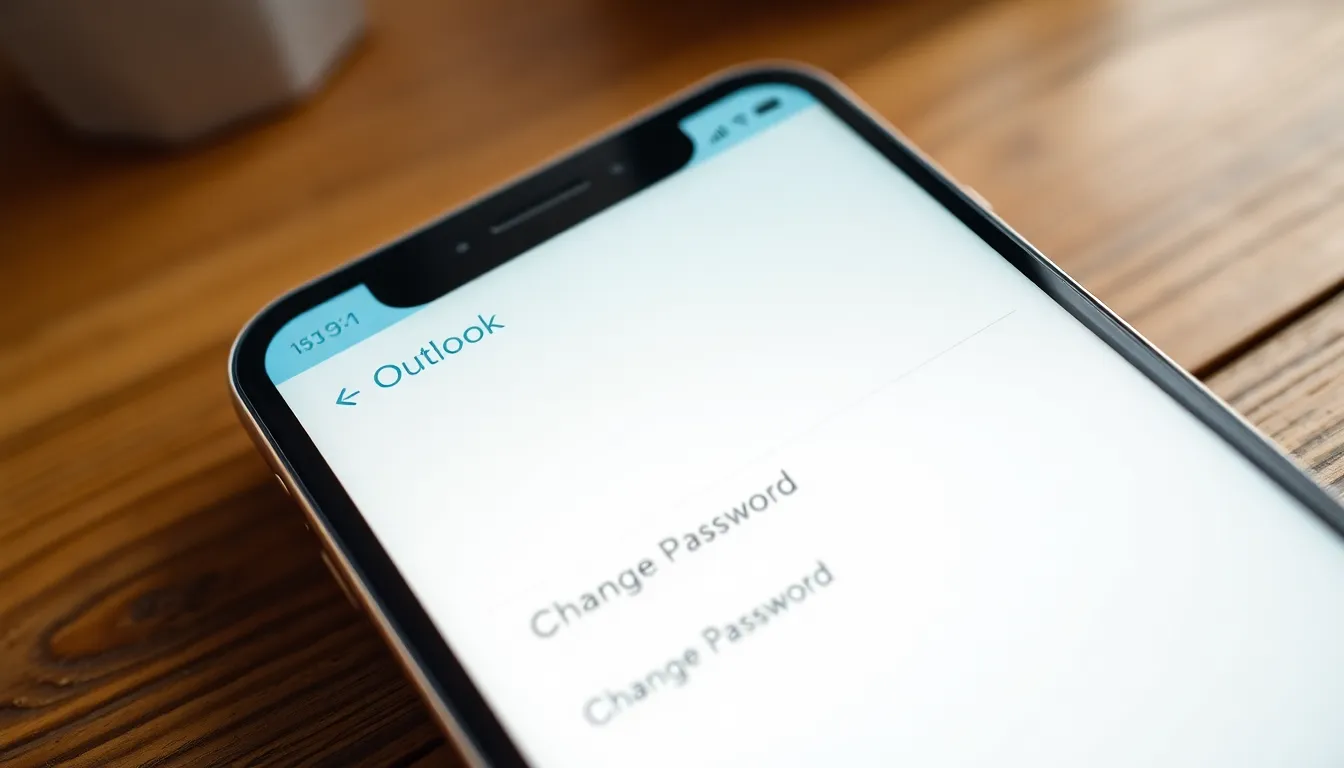Table of Contents
ToggleChanging your Outlook password on an iPhone doesn’t have to feel like solving a Rubik’s Cube blindfolded. With a few simple taps, you can secure your email and keep those pesky hackers at bay. After all, who wants to share their inbox with a stranger? Not you!
Overview of Changing Passwords
Changing passwords regularly enhances email security. For Outlook users on iPhone, the process remains user-friendly and efficient. First, determine if the current password requires updating due to security concerns or if a stronger password is preferred.
Begin by opening the Outlook app. Access the account settings by tapping on the profile icon. Next, select ‘Settings’ and then choose the appropriate email account.
The password update requires entering the old password, followed by the new password. Ensure the new password is strong, combining uppercase letters, numbers, and special characters.
Once the new password is inputted, save the changes. Re-login may occur during this process, reinforcing the update. Remember, failing to remember the new password can lead to access issues, necessitating recovery steps. Always keep a secure record of passwords, avoiding common or easily guessable options.
After completing these steps, the Outlook app might prompt users to enter the new password again for verification. This ensures seamless access to emails without interruption. Regular password changes serve as a proactive measure against potential security risks.
Secure emails today by following these simple steps for changing passwords.
Steps to Change Password for Outlook on iPhone

Changing your Outlook password on an iPhone involves a few straightforward steps. Follow these instructions to ensure that your email account remains secure.
Accessing Your Outlook App
Start by locating the Outlook app on your iPhone. Tap the app icon to open it. If prompted, sign in with your current credentials. Once inside, users will find the inbox and various features available. This initial step is crucial since it allows access to account management.
Navigating to Account Settings
Next, find the settings icon, typically represented by a gear symbol, in the top right corner of the screen. Selecting this icon opens the settings menu. Scroll down to find the “Accounts” section, where all linked email accounts appear. Tap on your Outlook account to proceed with updating the password.
Updating Your Password
After navigating to your account, look for the option labeled “Change Password.” Enter the existing password in the provided field. Following this, type in the new password, ensuring it meets security requirements by including a mix of uppercase letters, numbers, and special characters. Save the changes, then re-login if prompted, confirming the new password for continued access to your emails.
Troubleshooting Common Issues
Users might encounter issues during the password change process. Addressing these common problems can help ensure seamless access to Outlook.
Forgotten Password Recovery
If a password is forgotten, utilize the recovery option in the Outlook app. Navigate to the sign-in page, then click on “Forgot password?” A verification code will be sent to the registered email or phone. After entering this code, users can create a new password. It’s crucial to choose a strong password that combines uppercase letters, numbers, and special characters. Completing this process allows users to regain access quickly.
Syncing Problems After Password Change
Syncing issues may arise after changing the password. When the email account settings do not automatically update, users can manually adjust them. Open the Outlook app, go to settings by tapping the gear icon, and select the associated account. Enter the new password in the “Change Password” section. Restarting the app can also help resolve sync discrepancies. Ensuring correct input eliminates these common syncing problems.
Security Tips for Password Management
Regularly changing passwords enhances security. Use a combination of uppercase letters, lowercase letters, numbers, and special characters to create strong passwords. Avoid using easily guessed information like birthdays or names.
Unique passwords for different accounts lower the risk of breaches. He or she should never reuse passwords across multiple platforms. It’s essential to use a password manager to securely store them if remembering numerous complex passwords is challenging.
Two-factor authentication adds an extra layer of security. Enabling this feature requires a verification code in addition to the password, making unauthorized access much harder. Many email services, including Outlook, offer this option.
Monitoring account activity helps in identifying unauthorized access. Users should regularly check for any unfamiliar logins or changes in account settings. If any suspicious activity occurs, changing the password immediately is crucial.
Educating oneself about phishing attempts is vital. Phishing emails often appear legitimate and trick users into providing passwords. Recognizing these emails can prevent them from falling victim to scams.
Storing passwords in secure environments is important. Avoid saving passwords in browsers or on notes apps without encryption. Instead, using a dedicated password manager can keep sensitive information secure and readily accessible.
Reviewing and updating security questions can also strengthen account protection. He or she should choose questions and answers that only they can easily answer. Updating these regularly ensures continued security.
Changing the password for Outlook on an iPhone is a crucial step in maintaining email security. By following the outlined steps users can easily update their passwords and enhance their protection against unauthorized access. Regularly changing passwords and using strong combinations of characters is essential for safeguarding personal information.
Additionally users should consider enabling two-factor authentication and monitoring their account activity for any suspicious behavior. These proactive measures not only bolster security but also provide peace of mind. Staying informed about potential threats and taking action can significantly reduce the risk of falling victim to cyberattacks. Embracing these practices ensures a safer email experience.




